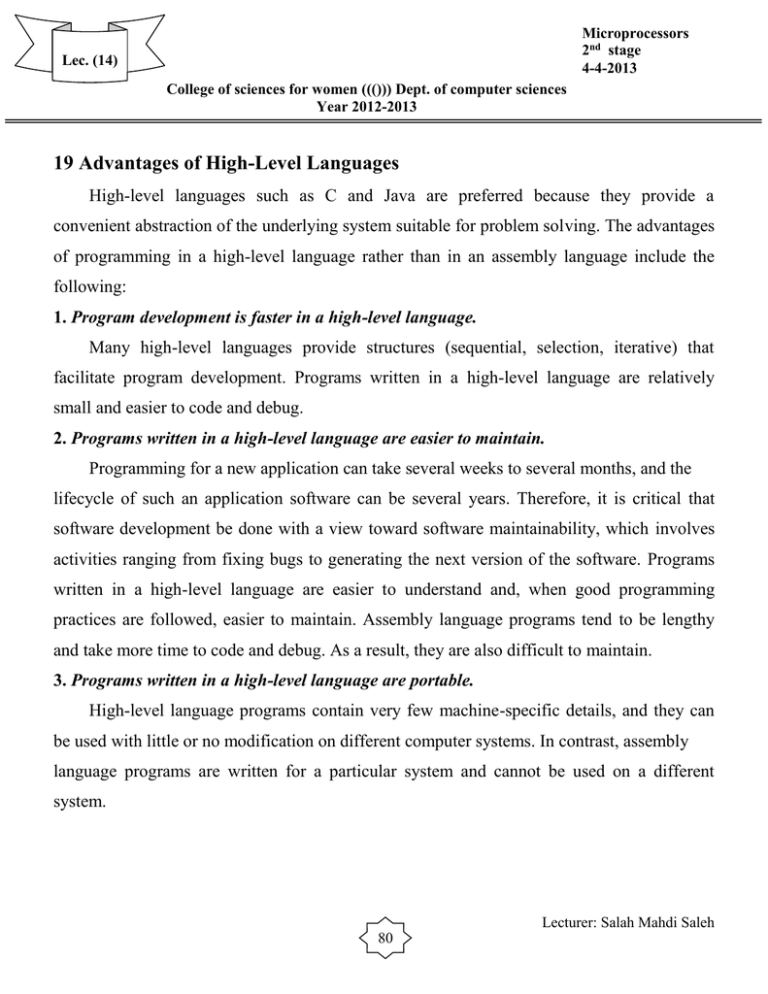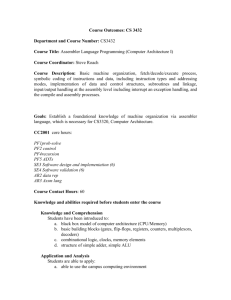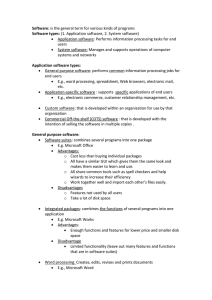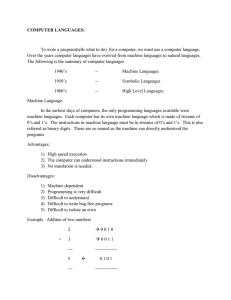Microprocessors 2 stage
advertisement

Microprocessors 2nd stage 4-4-2013 Lec. (14) College of sciences for women ((())) Dept. of computer sciences Year 2012-2013 19 Advantages of High-Level Languages High-level languages such as C and Java are preferred because they provide a convenient abstraction of the underlying system suitable for problem solving. The advantages of programming in a high-level language rather than in an assembly language include the following: 1. Program development is faster in a high-level language. Many high-level languages provide structures (sequential, selection, iterative) that facilitate program development. Programs written in a high-level language are relatively small and easier to code and debug. 2. Programs written in a high-level language are easier to maintain. Programming for a new application can take several weeks to several months, and the lifecycle of such an application software can be several years. Therefore, it is critical that software development be done with a view toward software maintainability, which involves activities ranging from fixing bugs to generating the next version of the software. Programs written in a high-level language are easier to understand and, when good programming practices are followed, easier to maintain. Assembly language programs tend to be lengthy and take more time to code and debug. As a result, they are also difficult to maintain. 3. Programs written in a high-level language are portable. High-level language programs contain very few machine-specific details, and they can be used with little or no modification on different computer systems. In contrast, assembly language programs are written for a particular system and cannot be used on a different system. Lecturer: Salah Mahdi Saleh 80 20 Why Program in Assembly Language? Despite these disadvantages, some programming is still done in assembly language. There are two main reasons for this: efficiency and accessibility to system hardware. Efficiency refers to how “good” a program is in achieving a given objective. Here we consider two objectives based on space (space-efficiency) and time (time-efficiency). Space-efficiency refers to the memory requirements of a program (i.e., the size of the code). Program A is said to be more space-efficient if it takes less memory space than program B to perform the same task. Very often, programs written in an assembly language tend to generate more compact executable code than the corresponding high-level language version. Time-efficiency refers to the time taken to execute a program. Clearly, a program that runs faster is said to be better from the time-efficiency point of view. Programs written in an assembly language tend to run faster than those written in a high-level language. As an aside, note that we can also define a third objective: how fast a program can be developed (i.e., the code written and debugged). This objective is related to programmer productivity, and assembly language loses the battle to high-level languages. The superiority of assembly language in generating compact code is becoming increasingly less important for several reasons. First, the savings in space pertain only to the program code and not to its data space. Thus, depending on the application, the savings in space obtained by converting an application program from some high-level language to an assembly language may not be substantial. Second, the cost of memory (i.e., cost per bit) has been decreasing and memory capacity has been increasing. Thus, the size of a program is not a major hurdle anymore. Finally, compilers are becoming “smarter” in generating code that competes well with a handcrafted assembly code. However, there are systems such as mobile devices and embedded controllers in which space-efficiency is still important. One of the main reasons for writing programs in assembly language is to generate code that is time-efficient. The superiority of assembly language programs in producing a code that runs faster is a direct manifestation of specificity. That is, handcrafted assembly language programs tend to contain only the necessary code to perform the given task. Even here, a Lecturer: Salah Mahdi Saleh 81 “smart” compiler can optimize the code that can compete well with its equivalent written in the assembly language. Perhaps the main reason for still programming in an assembly language is to have direct control over the system hardware. For example, writing an interface program, called a device driver, to a new printer on the market almost certainly requires programming in an assembly language. If you are developing system software (e.g., compiler, assembler, linker), you cannot avoid writing programs in assembly language. 21 Assembly Language Programming Programming in assembly can result in machine code that is much smaller and much faster than that generated by a compiler of a high level language. Small and fast code could be critical where resources may be very limited. In such cases, small portions of the program that may be heavily used can be written in assembly language. 21.1 INSTRUCTION MNEMONICS AND SYNTAX Assembly language is the symbolic form of machine language. Assembly programs are written with short abbreviations called mnemonics. A mnemonic is an abbreviation that represents the actual machine instruction. Assembly language programming is the writing of machine instructions in mnemonic form, where each machine instruction (binary or hex value) is replaced by a mnemonic. Clearly the use of mnemonics is more meaningful than that of hex or binary values, which would make programming at this low level easier and more manageable. An assembly program consists of a sequence of assembly statements, where statements are written one per line. Each line of an assembly program is split into the following four fields: label, operation code (opcode), operand, and comments. Labels are used to provide symbolic names for memory addresses. A label is an identifier that can be used on a program line in order to branch to the labeled line. It can also be used to access data using symbolic names. The maximum length of a label differs from one assembly language to another. Some allow up to 32 characters in length, others may be Lecturer: Salah Mahdi Saleh 82 restricted to six characters. Assembly languages for some processors require a colon after each label while others do not. The operation code (opcode) field contains the symbolic abbreviation of a given operation. The operand field consists of additional information or data that the opcode requires. The operand field may be used to specify constant, label, immediate data, register, or an address. The comments field provides a space for documentation to explain what has been done for the purpose of debugging and maintenance. 21.2 ASSEMBLY AND EXECUTION OF PROGRAMS As you know by now, a program written in assembly language needs to be translated into binary machine language before it can be executed. Figure 23 shows three steps in the assembly and execution process. The assembler reads the source program in assembly language and generates the object program in binary form. The object program is passed to the linker. The linker will check the object file for calls to procedures in the link library. The linker will combine the required procedures from the link library with the object program and produce the executable program. The loader loads the executable program into memory and branches the CPU to the starting address. The program begins execution. Figure 23 Assembly and execution process 21.2.1 Assemblers Assemblers are programs that generate machine code instructions from a source code program written in assembly language. The assembler will replace symbolic addresses by Lecturer: Salah Mahdi Saleh 83 numeric addresses, replace symbolic operation codes by machine operation codes, reserve storage for instructions and data, and translate constants into machine representation. The functions of the assembler can be performed by scanning the assembly program and mapping its instructions to their machine code equivalent. Since symbols can be used in instructions before they are defined in later ones, a single scanning of the program might not be enough to perform the mapping. A simple assembler scans the entire assembly program twice, where each scan is called a pass. During the first pass, it generates a table that includes all symbols and their binary values. This table is called the symbol table. During the second pass, the assembler will use the symbol table and other tables to generate the object program, and output some information that will be needed by the linker. 21.2.2 Data Structures The assembler uses at least three tables to perform its functions: symbol table, opcode table, and pseudo instruction table. The symbol table, which is generated in pass one, has an entry for every symbol in the program. Associated with each symbol are its binary value and other information. The opcode table provides information about the operation codes. Associated with each symbolic opcode in the table are its numerical value and other information about its type, its instruction length, and its operands. The entries of the pseudo instruction table are the pseudo instructions symbols. Each entry refers the assembler to a procedure that processes the pseudo instruction when encountered in the program. For example, if END is encountered, the translation process is terminated. In order to keep track of the instruction locations, the assembler maintains a variable called instruction location counter (ILC). The ILC contains the value of memory location assigned to the instruction or operand being processed. The ILC is initialized to 0 and is incremented after processing each instruction. The ILC is incremented by the length of the instruction being processed, or the number of bytes allocated as a result of a data allocation pseudo instruction. Lecturer: Salah Mahdi Saleh 84








![COURSE NUMBER/TITLE: CS-145 [354-145] COMPUTER SCIENCE II CREDITS:](http://s2.studylib.net/store/data/010725452_1-ae5f1fba080ab698a7d42242aabf0333-300x300.png)